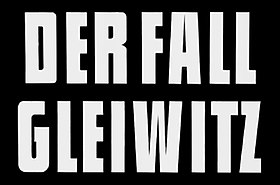The Gleiwitz case
| Movie | |
|---|---|
| Original title | The Gleiwitz case |
| Country of production | GDR |
| original language | German |
| Publishing year | 1961 |
| length | 63 minutes |
| Rod | |
| Director | Gerhard Klein |
| script |
Wolfgang Kohlhaase , Günther Rücker , Klaus Wischnewski (dramaturgy) |
| production |
Erich Albrecht KAG “Berlin”, DEFA |
| music | Kurt Schwaen |
| camera | Jan Čuřík |
| cut | Evelyn Carow |
| occupation | |
| |
The Gleiwitz case is a DEFA feature film from 1961. According to statements made by SS man Alfred Naujock before the British interrogation authorities and during the Nuremberg Trial, the plot has been meticulously reconstructed.
action
The film deals with the attack staged by the SS on the Gleiwitz transmitter on the evening of August 31, 1939, which, along with other events, served National Socialist propaganda as a pretext for the attack on Poland at the beginning of the Second World War.
The opening shot shows the cinema showing a newsreel that glorifies the war and reports on a military parade. Among the audience is SS-Hauptsturmführer Alfred Naujocks (in civilian clothes) , who can be heard from his point of view as the narrator of the events in some passages of the film.
Gestapo chief Müller recruited ethnic German SS members, including Naujocks, to stage attacks by Polish irregulars on German institutions in disguise . At the same time, individual Polish concentration camp prisoners are being transferred to places in the border area. Polish uniforms and weapons are provided for the task forces.
After placing an interfering noise , Naujocks uses a forged ID card and Reichspost uniform to gain access to the station (which only broadcasts the program of the station Wroclaw as a relay station and therefore has few staff) in order to orientate himself there.
A concentration camp inmate - prepared as an alleged perpetrator - is said to be shot at the transmitter following the attack. To this end, an auxiliary policeman is initiated who would later testify that he shot a fugitive. A doctor who was also privy to the prison gave the inmate an injection that anesthetized him for three to four hours, so that an autopsy would show that death only occurred after the shot.
The group around Naujocks does not drive in uniform, but in civilian clothes with two cars to the transmitter. On the way there, the Gestapo gives them the drugged prisoner and a K98 carbine for his murder , which the local police station also has. A man from the Schutzstaffel climbs over and opens the gate to the facility, the group enters the building and locks the technicians in the basement.
Naujocks found the emergency microphone in a cupboard , interrupted the program and had a bilingual subordinate read out a German and Polish appeal. Meanwhile, the others smash some furniture as background noise for the broadcast. After a few minutes, Naujocks breaks off the announcement, the group leaves the station before the police arrive, and a man from the Schutzstaffel shoots the prisoner who has just woken up in front of the station.
In the final shot, the men walk away from the camera towards the transmitter mast . In the background, a part of Hitler's radio address of September 1, 1939 can be heard, which ends with the words “They have been firing back since 5:45 am”, followed by the first stanza of the Deutschlandlied . Above this, the text "43,000,000 dead" is faded out at the end.
background
The film was shown in GDR cinemas on August 24, 1961 - a few days after the Berlin Wall was built . The film was shot on the original location from August 1960 to March 1961. Due to a decision by the Adenauer government, the film could only be shown two years later in West Germany as part of film club events.
Reviews
"The impressive film, a parable of the mechanical execution of orders in a totalitarian dictatorship, convinces with its cool, geometric images and a direction that abstracts from all trivialities."
"I come across as arrogant, so from the outside I am suitable for these roles, which, through their thorough design ... make clear the whole danger of these criminals in SS uniform."
The SED functionary Alfred Kurella missed the positive in the film, the lack of anti-fascist resistance. Arno Röder criticized “conception, content and artistic statement” as “inadequate”.
Web links
- The case Gliwice in the Internet Movie Database (English)
- The Gleiwitz case at filmportal.de
- The Gleiwitz case at the DEFA Foundation
Individual evidence
- ^ The case of Gleiwitz Landesmediendienste Bayern
- ↑ a b Berliner Zeitung: Fifty years ago the film "Der Fall Gleiwitz" was released on September 17th, 2011
- ↑ 2016-12-28 in the Lexicon of International Films
- ↑ Archived copy ( memento of the original dated November 7, 2017 in the Internet Archive ) Info: The archive link was inserted automatically and has not yet been checked. Please check the original and archive link according to the instructions and then remove this notice.
